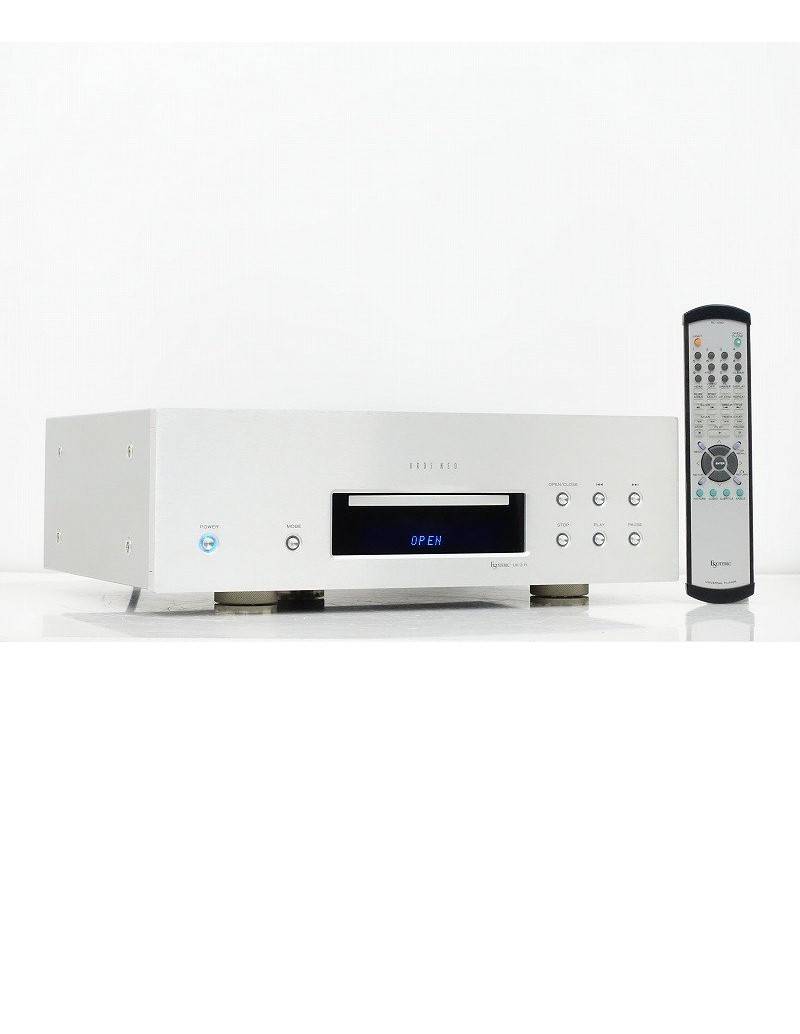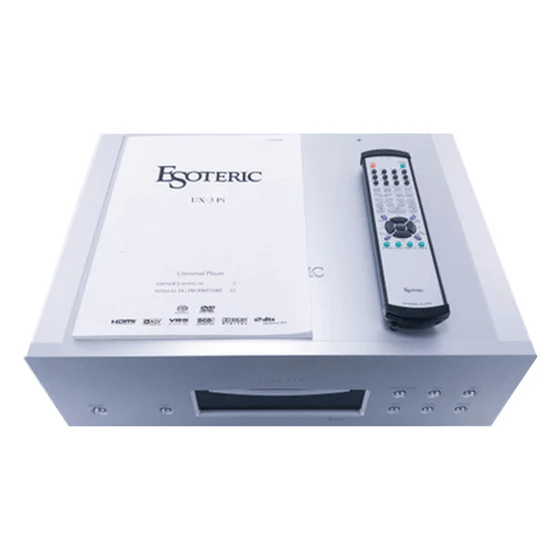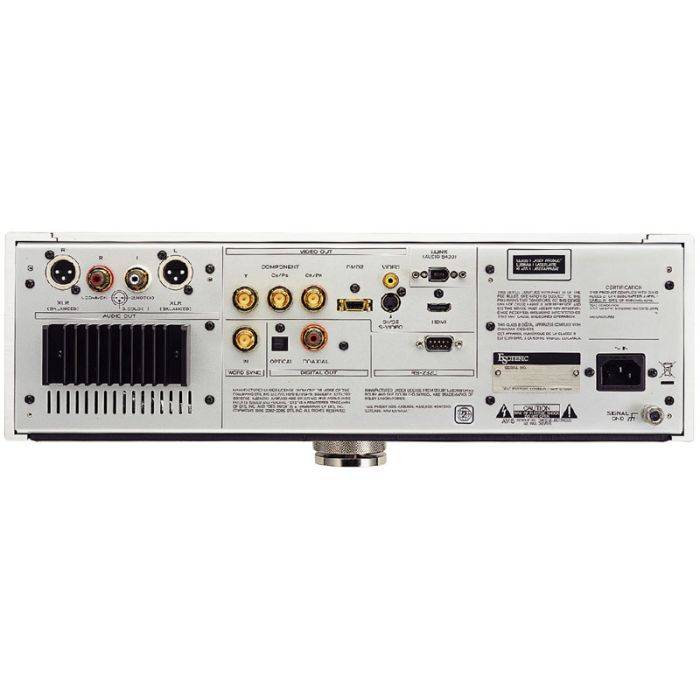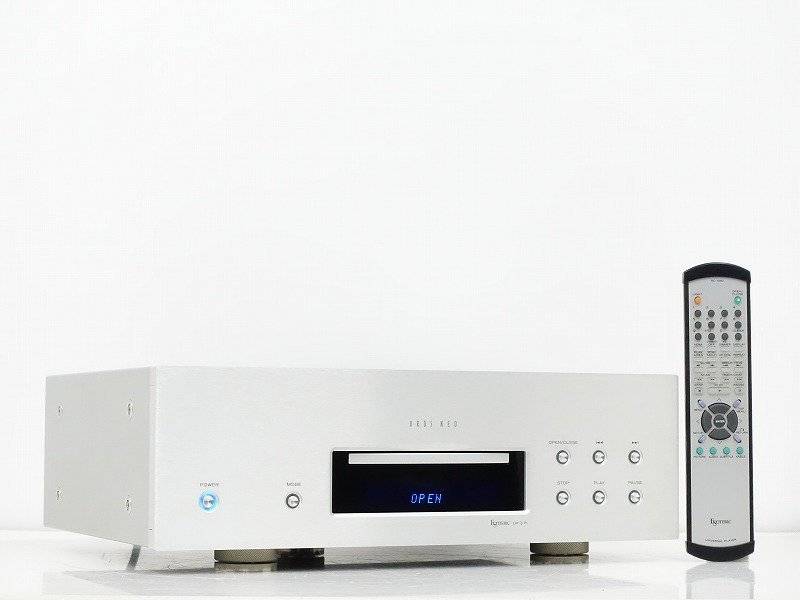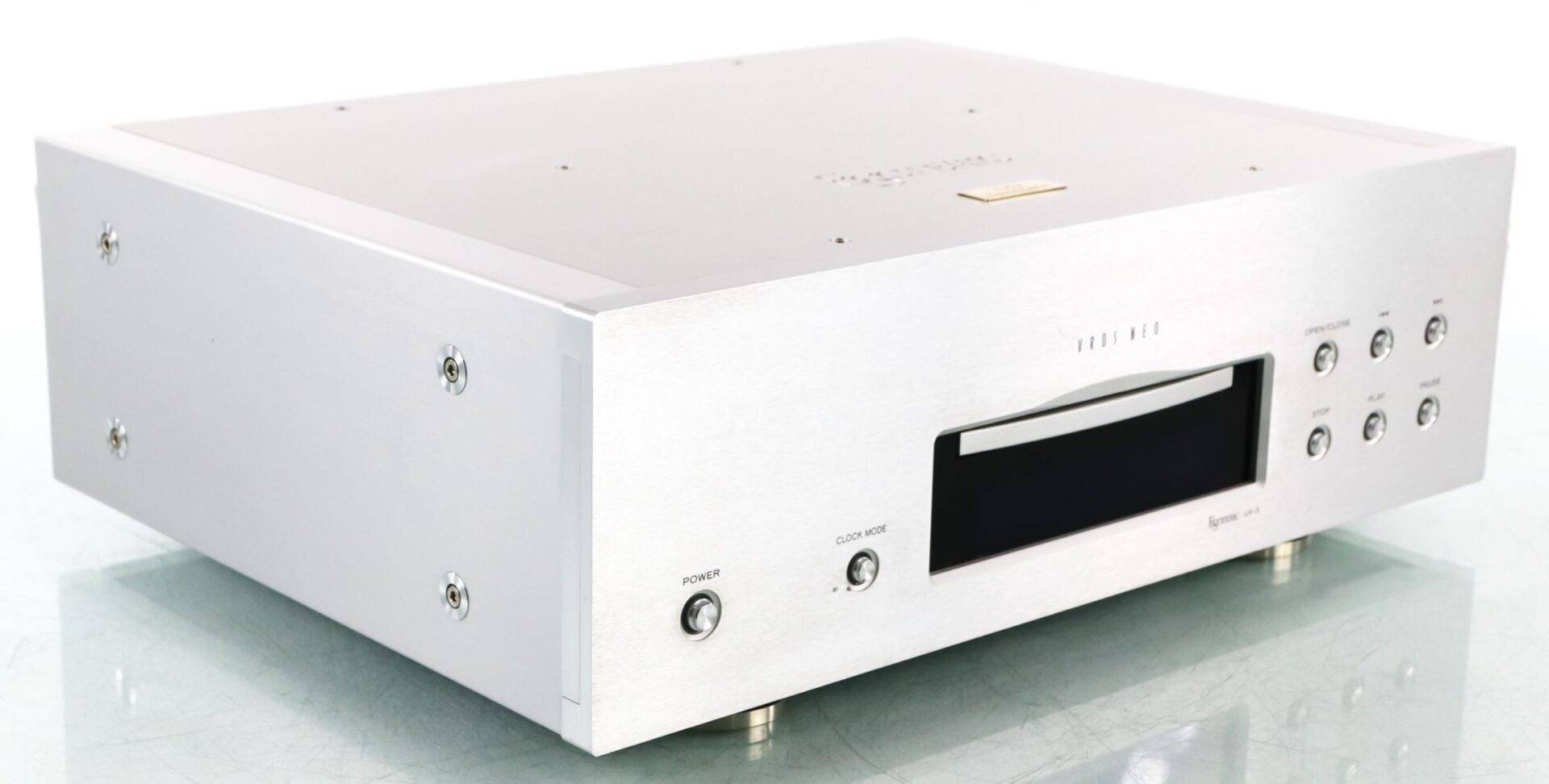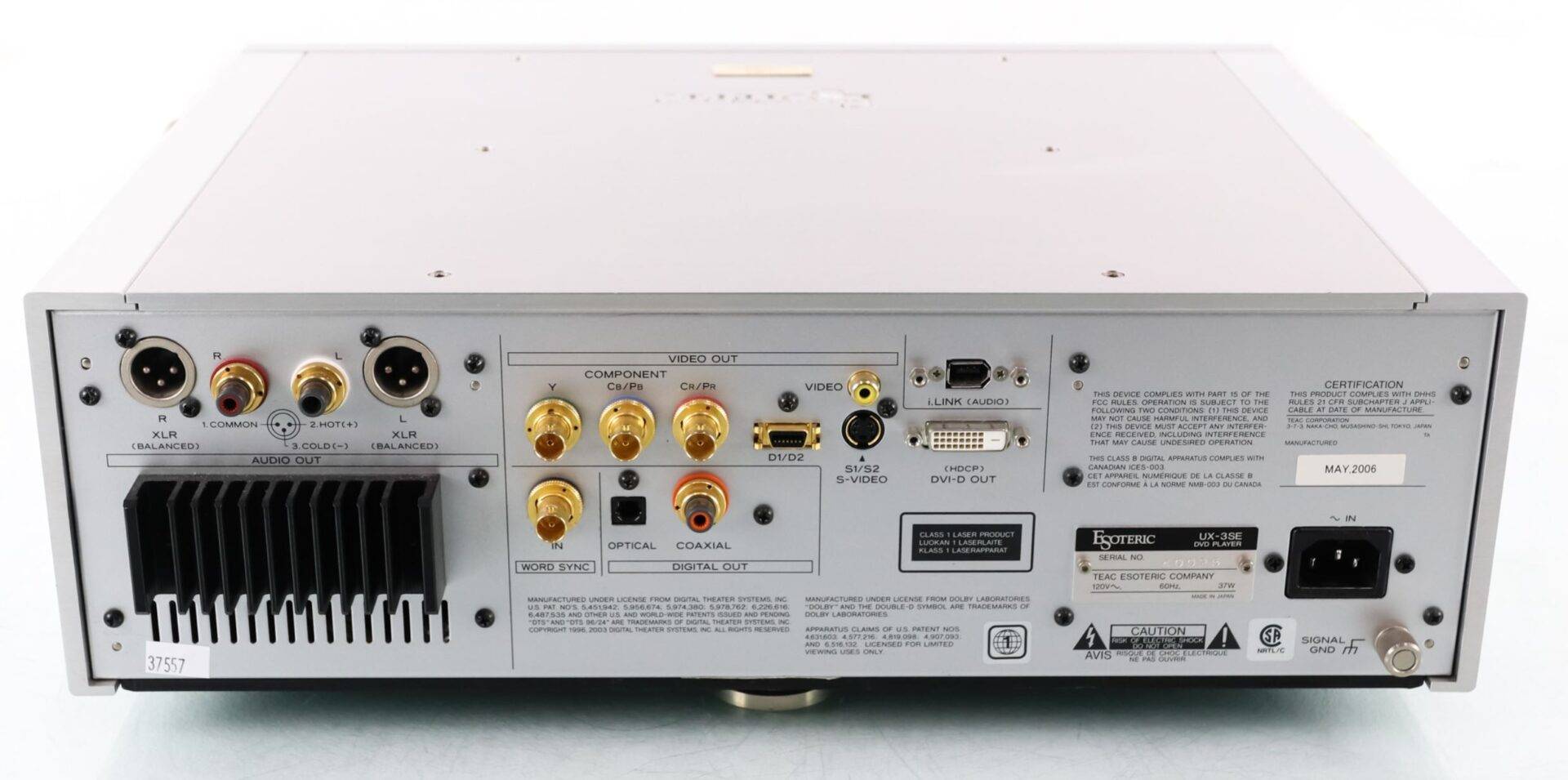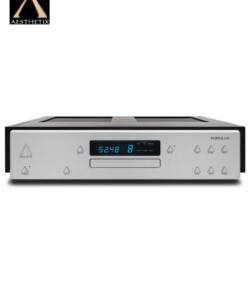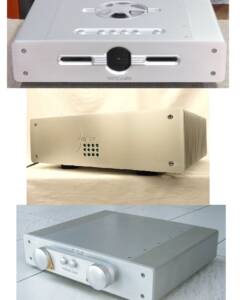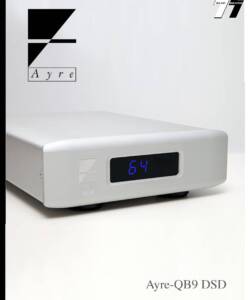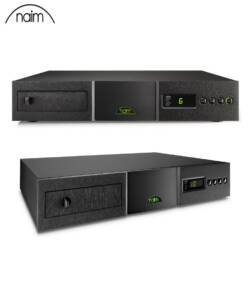Esoteric UX-3 Universal Audio/Video Player
Original price was: R130,000.00.R56,000.00Current price is: R56,000.00.
Specification
Frequency response: 5Hz – 80 kHz (DVD-Audio)
Signal-to-Noise Ratio: 112 dB (Super Audio CD 1kHz)
Dynamic range: 106 dB (Super Audio CD, 1kHz)
Total harmonic distortion: 0.001% (Super Audio CD, 1kHz)
Decodable format: DTS, DTS 96/24, Dolby Digital PCM 44 1kHz-192kHz/16-24 bit, DSD
Plays: DVD-Video, DVD-Audio, DVD-R/RW, Video-CD, Super Audio CD, and CD
Power Supply: AC 120V, 60Hz (USA/Canada model) / AC 220V, 60Hz (Korea Model)
Power Consumption: 37W
Weight: 23.5kg (51.8 lbs)
External Dimensions: W17-3/8 x H6 x D13-7/8 (442mm x 153mm x 353mm)
Price: $8,500.00
Description
Review Summary
|
|
All of us like to think we get what we pay for. Whether we buy the latest luxury SUV or name-brand macaroni and cheese at the grocery store, more money should buy better quality. This is especially expected in high-end audio, where costs can be quite high — seemingly out of proportion with the vast majority of consumer electronics. If the price tag is steep, our expectations are that the product offers a commensurately higher level of performance than lesser-priced alternatives.
However, most of us learn early on that cost does not guarantee quality — or satisfaction. There have been occasions where I’ll get a product for review and think to myself: It costs how much? Simply buying the most expensive components and assembling them haphazardly is a recipe for bad sound. Conversely, there have been many products over the years that are impressive in what they offer despite the fact that they cost a very substantial sum of money.
And that brings me to the $8500 USD Esoteric UX-3 universal audio/video player.
A lot for your money
The UX-3 is one substantial component relative to just about every other source I’ve used. Unboxing it, you’ll get a feeling of satisfaction; hefting it onto your rack you’ll have no question that you bought a real component designed to last a lifetime, not a throwaway item that’ll need replacing in a few years. The three point-in-cup feet insure perfect leveling as you set the UX-3 down, and they’ll provide a degree of isolation from the vibrations inhabiting your listening room. The remote is chunky and full-sized, not a credit-card-shaped job that seems to be all the rage. Simply put, the 55-pound, 17 3/8″W x 6″H x 13 7/8″D UX-3 is gorgeous. Its gleaming aluminum front panel and super-heavy-gauge steel chassis make for vault-like construction.
Although the UX-3 is quite arresting from an audio-jewelry perspective, the most impressive technology is tucked away. And though it has functionality far beyond your typical CD player’s, the front-panel layout is so clean and uncluttered that you’ll wonder just what it is the UX-3 does. Chalk the austere look up to great industrial design. The truth is that the UX-3 is not a simple product, nor is there anything else like it, at least that I’m aware of, in the high-end marketplace.
So what does it do, and why? It plays stereo SACD and stereo DVD-Audio/Video, as well as good old Red Book CD through its RCA and XLR analog outputs. It will also send a multichannel digital signal, via an iLink connection, to a properly equipped receiver or processor for playback of the two high-resolution music formats (and DVD-Video). The UX-3 also outputs progressive-scan video through a bank of outputs: component, composite, S-video, D terminal, and DVI. It uses an Analog Devices ADV7314 216MHz multiformat video encoder with six 14-bit video DACs.
Did you catch what’s different? That’s right — there are no analog multichannel outputs on the UX-3. This fact alone differentiates it from just about every other universal audio/video player on the market. (There are a few exceptions, such as the Ayre C-5xe. But that player has no video section, which differentiates it.)
Although I was at first a bit confused by the UX-3’s output configuration, the more I thought about it the more sense it made. Consider this: many (maybe even most) of those interested in the high-resolution music formats have not bothered to set up multichannel systems. For them, stereo playback is the purist endeavor they enjoy, and that is not about to change. For those who do have multichannel systems, they’re likely interwoven with home theaters. Undoubtedly, they have fancy processors and the like that control those complex systems.
Simply put, the pure analog multichannel preamp never really caught on; therefore, there’s simply no need to have six-channel analog outputs when in most cases they won’t be used. Esoteric, seemingly, has figured this out. I wonder if we’ll begin to see more players configured like the UX-3.
Highlights
The principal highlight of this or any Esoteric source component above the company’s DV-50S is the transport mechanism. The UX-3 houses Esoteric’s proprietary, built-in-house VRDS-NEO transport. The version in the UX-3 is slightly less Herculean than that used in the company’s more costly UX-1 and X-01, but it is still an incredible work of engineering art. The goal of the VRDS transport is to eliminate any vibration of the disc, as well as to correct small inconsistencies in disc flatness. It accomplishes these tasks by clamping the disc with a circular plate that runs the full diameter of the disc. According to Esoteric, this also serves to reduce read and timing errors. Construction highlights of the UX-3’s VRDS-NEO include a duralumin turntable and a bridge made from 10mm SS400 steel. Seeing the VRDS-NEO next to the Pioneer transports that most all of the other players on the market use is eye opening. It’s like the difference between an inexpensive sub-compact car and a Lexus flagship — night and day.
The design details that will affect two-channel audio performance are impressive. Audio DACs are 24-bit PCM1704 Burr-Browns in a dual-differential configuration identical to that of the more costly UX-1. And like the UX-1 (and X-01), the UX-3 converts the DSD data stream to 88.2kHz PCM and then to analog. Esoteric does this for reasons of its own, all of which make for better sonics in the company’s opinion.
The chassis is separated into three sections to provide robust shielding between the power supply, the transport, and the output stages. Output jacks are robust, chassis-mounted types. Separate power supplies are employed for the DACs, the digital circuitry, and the analog stages. The video outputs can be turned off when listening to audio-only program material. A removable IEC power-cord socket is supplied so that you can use an after-market cord (in my case, a Shunyata Research Diamondback). Clearly, Esoteric has focused on two-channel sound with the UX-3, and that’s how I used it in my system.
Setting up
I connected the Esoteric UX-3 to my Boulder Amplifiers 1010 preamplifier with a set of Shunyata Research Antares balanced interconnects, which then fed, via another set of Shunyata Antares XLRs, the matching Boulder 1060 stereo power amplifier. The speakers were my long-time reference: Wilson Audio Specialties Alexandria X-2s. The majority of my time with the UX-3 was spent in my newest upgrade, the Music Vault listening room, which you can read about on Ultra Audio in my “The World’s Best Audio System” column. All components were plugged into a Shunyata Hydra Model-8 power conditioner, which was fed by a dedicated 20A line that terminates in one of the company’s Venom outlets. Speaker cables were Shunyata Orions.
Spinning discs
The Esoteric UX-3 handled anything and everything I threw at it — with ease. It’s not lush or polite; it offers great clarity and detail retrieval, along with the ability to play both large- and small-scale works equally well. With whatever format I chose to listen, the UX-3 was a sonic delight in every regard. It was also operationally solid, with no glitches to report — including the large remote. It is a wholly realized machine, inside and out.
I’m a big fan of anything from Chris Cornell. I went through college listening to Soundgarden and have had Audioslave’s Out of Exile [Interscope 000 460 302] in my to-play pile for months. In between those two gigs, however, Cornell had a short solo career, and one of my favorite tunes, “Sweet Euphoria” from Euphoria Morning [Interscope 90412], is always one of the first tracks I play when auditioning gear. I know its nuances well. The sound of that track has a slightly ethereal quality in the vocals, though the guitar work is incisive, deliberate and more up front. The UX-3 gave the ax plenty of bite, while the vocals had excellent clarity and spot-on tonality. The somewhat distant acoustic chosen for the song, with that etherealness intact, served as the perfect backdrop for the enigmatic lyrics. The UX-3 was off to a good start having passed the Cornell Test, and I was having fun already.
Sarah McLachlan’s The Freedom Sessions [Arista 07822-18784] is a raw, bare-bones presentation of some of her better works. In this 1995 release McLachlan’s band displays a level of unbridled energy that at times overwhelms her vocals, but it gives the album a more authentic feel that will please the live rocker in you. The last track, although listed simply as “Ol’ 55,” actually contains the album’s second version of “Hold On.” It starts at around the 4:40 mark, 35 seconds or so past the end of the previous song. You wouldn’t find it unless you just let the CD run.
I’ve always liked this version of “Hold On” best because it seems the least rehearsed and contains tons of raw acoustic energy. The musicianship is at once laid-back and hard-hitting, which takes a system that can project significant amounts of air into the room while still maintaining the song’s nuances. My system, anchored by the UX-3, produced an incredibly satisfying drum kit and incisive drive from the guitar, but it also got the subtle inflections in McLachlan’s voice right. This disc player is not at all subdued — it seems to like to get you involved in the proceedings, not simply have you as an observer. Its frequency extremes are plenty apparent, and its midrange is present and clear. I heard, on The Freedom Sessions and many other discs I played, a level of detail in vocals that I simply have not heard with lesser players. No issues with the UX-3’s CD playback.
The flute on the enchanting “Simple Gifts” (A Celtic Spectacular SACD [Telarc SACD-60571]) is woven in and amongst the soundscape in a way that requires it to be cleanly delineated but at the same time rhythmically connected to the rest of the instruments. It requires a player that can sort out complexity while not spotlighting any particular frequency. The UX-3 proved to be neutral in that regard, while able to keep fine high-frequency details dense and whole. This proved to me that the UX-3 was capable of producing both micro- and macrodynamics with equal acuity. Whether you gravitate to large-scale symphonic works or more intimate jazz recordings, if my experience is any indication, you’ll be able to enjoy both equally as played with the UX-3.
The UX-3 does not homogenize detail; it sorts things out to a striking degree. The introduction to Mike Oldfield’s Tubular Bells 2003 [Warner R9 60204] was cast on a tonally rich soundstage in my room. The music was rendered with satisfying pace and rhythm, with dynamic shading to spare. When the bass line comes in at about a minute into the track, the added energy did not take away from the already-present instrumental forces.
Can the UX-3’s performance be bettered? Frankly, I’ve not heard Ed Meitner’s latest EMM Labs combo, but the DAC6e/ Phillips SACD 1000 setup was not equaled by any other player near its price (around $12,000 when I last heard it) — perhaps until now. Without a head-to-head confrontation between these two sources, I can’t really proclaim a loser, just two winners.
When you are considering a universal player like the UX-3, you also have to consider the future of the SACD and DVD-A formats. Will they be around for much longer? How much new music in those formats will you have to choose from? In my case, because I have a considerable number of high-resolution discs in my collection, I need something good to play them on. Aside from that consideration, however, is that the UX-3 is an outstanding CD player and does video as well. I’m sure I’ll take advantage of the home-theater aspect of the UX-3 at some point, but I know it’ll get daily use in my system as a CD player. You’ll have to sort all of these considerable details out for yourself when determining whether the UX-3 fits your ideal. With HD DVD and Blu-ray on the horizon, the picture gets even cloudier.
Comparison
I owned Esoteric’s popular DV-50 universal A/V player ($5500), which is sonically identical to the current DV-50S ($6000). I enjoyed every moment I used it. The DV-50 adds multichannel analog outputs to the feature set, beneficial if you will use them in your system, and is a wonderful-sounding player in its own right. It is, however, easily trumped in terms of two-channel sound quality by the $3000-more-expensive UX-3. The UX-3 sounds weightier and more robust in the vocals. It is quicker and punchier in the midbass, and also casts an ever so slightly more accurate soundstage. These improvements were apparent with most every type of music I played. The DV-50 might be termed a bit more polite, but in my system the level of dynamic energy and weight that the UX-3 produced was all positive, all the time. The price of a used DV-50 or new DV-50S might make it more attractive to you, and I don’t think you’d be disappointed with either anchoring your system, but in absolute terms there is no real comparison in sound quality: the UX-3 wins hands down.
As I’ve noted, the UX-3 converts DSD to upsampled PCM, whereas the DV-50 and DV-50S do not. Banish your preconceived notions about how the various technologies are implemented. Just listen and you’ll hear immediately which is superior. The engineers at Esoteric obviously know what they’re doing — the UX-3 does SACD justice in every regard.
Final assessment
If you are first and foremost a two-channel audiophile, the UX-3 should suit you well. That’s its focus, clearly. If you might want to enjoy some DVD-V over your stereo, and if that might include decoding surround sound at any time in the future, the UX-3 has the facilities to let you do those things with a little more investment in gear. That strikes me as the perfect balance for many users reading this review. You don’t have to pay for multichannel analog outputs that you aren’t going to use, but you can, with some effort, go the surround-sound route down the road.
You also get an engineering tour de force that will elicit pride of ownership and should last virtually forever. Having lived with Esoteric’s insanely priced P-01/D-01 separates as well as the popular DV-50, I can confidently say that the UX-3 is my favorite Esoteric to date. You get a generous taste of the best at a price that is below what many consider the entry fee to the state of the art. I can’t imagine anyone being disappointed with the UX-3. I can imagine it being the last player you will want to buy for some years to come.
Taking the Next Step in Digital Audio
Digital audio has really taken off over the last couple of years, and all but the most hardcore vinyl devotees have recognized it. I think we all have a friend or know of someone who says that when all is said and done, “it’s not as good as vinyl”, then turns their nose up as the little 5.25 inch disc spins on the platter. I would say the previous generation of players made huge strides in what we would typically call warmth and sweetness in the musical reproduction to the point that we could stop pulling out the vinyl copy of the CD and compare them for differences. I will not say that I have heard everything out there that digital has to offer, but feel comfortable making a few generalizations. There were three rather popular CD players that most of us audiophile-types had some sort of experience with at one time or another. Those would be the Electrocompaniet EMC-1, Cary 306/200 and the Esoteric DV50. All three are wonderful performers and all 3 were in that magical $5-6K price range. All 3 players had their own set of strengths and weaknesses. Again, just generalizing, the Electrocompaniet player seemed to have slightly better dynamics and transient response than the others but did not have as much naturalness or warmth. The Cary player has a very pleasant, sweet sounding midrange presentation, but also seems to have a slight midbass emphasis that can be annoying at times. Of the 3, the Esoteric DV50 appeared to have a good balance across the board with most of the strengths and none of the weaknesses of the other two players. Let me be careful to say that even though I might call them weaknesses, they very well could be strengths to someone else and the determining factor as to why a person would buy one of the other players. Interestingly enough, the Cary player has been replaced by the 306/300 and Esoteric’s DV50 has been replaced by the DV50S. So of course, when Clement Perry asked me how I was doing with my digital rig and if I would like the opportunity to do a review on one of Esoteric’s newest offerings, the UX-3, I jumped at the opportunity.
I feel like I’m surfing on a giant digital wave, and I’m right there on the edge of some very exciting breakthroughs. Esoteric seems to be a consistent performer in this realm and are really turning out some truly breathtaking products. I was at one of my favorite local audio “watering holes” and they had an Esoteric UX-3 and a G-25U Upsampler/Clock Generator as the front-end in their high-end system. It was a truly amazing sounding system. I commented to them that their system had never sounded that good before, even when using an analog based front-end. Such are the types of responses that Esoteric’s digital offerings have been garnering of late. Esoteric seems to have taken a large step forward in the furtherance of digital playback. The UX-3 Universal disc player is just one of the fruits of this commitment to produce excellent sounding and performing equipment.
 A Well Built, Well Designed Player
A Well Built, Well Designed Player
The Esoteric UX-3 is a large, solid, and rigidly built machine that instills nothing but the highest amount of confidence in the way it performs. Weighing in at more than 50lbs, it is one of those pieces that once you figure out where you’re going to locate it, you leave it there and get settled in for the long haul. The UX-3 doesn’t have a lot of bells and whistles on the outside, and it doesn’t put on any type of George Lucas light show. But what it does give you is what I like to think of as “understated elegance.” Much like a well-made BMW 7-Series automobile, all of the goodies reside under the hood and are easier heard than seen. The unit I reviewed has a beautiful brushed aluminum finish. Some of the technology used in the UX-3 was borrowed from Esoteric’s flagship UX-1/X-01 players and clearly helps to set this player apart from others at this price point. Key among these innovations is the Vibration-free Rigid Disc-clamping System a.k.a. the VRDS NEO Mechanism. This is a massive transport that securely handles your discs and retrieves that last bit of information contained within.
In operation, the UX-3 is dead quiet. After putting up with the nerve-racking way that the Cary 306/200 handled CDs, with its drawer opening and closing at breakneck speed, the smooth, quiet mechanism of the UX-3 is a welcome change. The only times you hear the slightest sound coming from the UX-3 is when the drawer open or closes and when it loads the disc into playing position. Another touch I rather enjoyed was the tray itself. The tray is processed from a solid aluminum block while the disc contact side of the tray is coated for disc protection. There is a 1 ½”-inch hole off center that makes placing and removing discs on the tray a whole lot easier without putting any undue stress on the tray. That’s what I would call a touch of thoughtful, ergonomic engineering.
There are eight pushbuttons on the front of the unit. The two buttons on the left are for “POWER” and selecting the “CLOCK MODE” if you have an external word sync source connected to the back of the unit. I’ll have more on this in a moment. The other six buttons are for the basic functions: “OPEN/CLOSE”, “STOP”, “PLAY”, “PAUSE”, and “SKIP” (forwards and backwards). There is a soothing cobalt blue light that emanates from behind the selected button. The display characters are blue as well and I was able to easily read it from my seated position, over 15’ away.
The rear panel is where things begin to get interesting. Keeping in mind that this is a universal player, the UX-3 offers its owner a large amount of flexibility with both audio and video connections. For audio, you have your choice of single-ended (RCA) or balanced (XLR) outputs, single-ended digital and optical digital out, and a “word sync” input to connect an external device such a “word clock generator.” From what I understand, devices such as “word clock generators” (such as Esoteric’s own G-25U or G-Os/G-O) go a long way toward removing jitter noise and such audible artifacts that we take for granted as just being part of the recording. The job it does is subtle, and upon first listen, may not seem to be making an impact on the listening experience. Take it out of the system and you will definitely hear the difference this device makes and you’ll want to put back right away. The UX-3 allows you to plug in one of these devices directly. It also has an “i.-Link Audio” output for digital surround audio from SACD and DVD-A audio discs. Now, I do not have a surround sound system so I did not test this unit’s i.-Link capabilities, but I did see a demonstration of it at one of the local dealers’ and it really does work. If you have a surround sound system and can use the features the UX-3 offers for taking advantage of i.-Link technology, your listening experience with multi-channel SACD or DVD-A will be enhanced even more so. When playing a conventional DVD video disc, the multi-channel signal’s output can come from your choice of coax digital or optical (Toslink) connectors. The back panel also has composite, S-Video, and component video (via BNC connectors) video outputs. Whatever your digital audio/video system needs are the UX-3 can readily be placed in the middle and elevate the performance of your setup.
It Even Sounds Esoteric
There is a lot more about this player that I could have talked about, such as the hardened steel pinpoint isolation feet the UX-3 rests upon and some of the programming flexibility, but that would take up a lot more space and not allow me to share with you what ultimately is what matters to all of us. Performance is what this player has a tremendous amount of. It’s hard for me to focus in on a specific strength of this player because it does so many things “more right” than what I have been accustomed to listening to. It made my best sounding discs sound better than I thought imaginable. We all have SACDs that are well recorded and some that were poorly recorded. Well-recorded SACDs have a breathtaking realism that remind me why I spent the extra money for them. The average everyday red book discs actually sound surprisingly good and discs that I wouldn’t play because of bad recording, were suddenly as a good listen. By this, I mean to say that the discs were still bad, but I could at least appreciate the performance more in spite of what was going on inside of the recording studio. If you are familiar with the very popular and excellent sounding Esoteric DV50, and this may be hard to do, but just imagine every performance aspect of that player being bettered and you’ll just start to realize how good the UX-3 is. Upper frequency information contains more air, more ambience, and more life but not at the expense of sounding strident, edgy or enhanced. Instruments decay naturally and notes seem to linger ever so slightly longer without seemingly being cut short. The UX-3’s midrange was neither overly detailed nor was it “warm” as these terms do not apply. The midrange sounded natural, clear and coherent and allows you to follow individual instrumental lines, such as those in Latin jazz or the dulcet tones of a string ensemble quite easily. Bass is authoritative, deep, full, without any bloat, and has a surprisingly large amount of detail. Listen to any bowed instrument and the amount of information from the bow traversing the strings will astound you. Images are locked in, palpable and project presence in three dimensions across a wide and deep stage.
From the Victor Wooten & Steve Bailey CD Bass Extremes [Tone Center], the track “Tropical Storm” gives a good rendering of the UX-3’s dynamic capabilities. The bass playing assault on the senses provided by these two heroes combined with the driving percussion were handily on display without any softening of impact or dulling of transients. At the same time, when the music called for a smooth, tuneful re-creation, the UX-3 was more than up to the task.  The track “People Make the World Go Round”, from the discSunflower, shows Milt Jackson doing some of his best work, coaxing the melody from the keys. Female vocals were portrayed as rich, breathy and detailed. Jacintha’s, “One For My Baby” from her Autumn Leaves CD [First Impression] came from a totally black background and caused her to magically appear in my listening room as it was easy to close my eyes and feel her presence. Actually, all of the discs I played for vocal testing had this eerie ability to make singers magically appear into my room. Large orchestral works were delivered in grand fashion. Gustav Holst’s classic composition, The Planets, is a sonic spectacular. This is an Ultradisc UHR SACD [UDSACD 4005] copy of this performance with Walter Susskind conducting the Saint Louis Symphony Orchestra. F
The track “People Make the World Go Round”, from the discSunflower, shows Milt Jackson doing some of his best work, coaxing the melody from the keys. Female vocals were portrayed as rich, breathy and detailed. Jacintha’s, “One For My Baby” from her Autumn Leaves CD [First Impression] came from a totally black background and caused her to magically appear in my listening room as it was easy to close my eyes and feel her presence. Actually, all of the discs I played for vocal testing had this eerie ability to make singers magically appear into my room. Large orchestral works were delivered in grand fashion. Gustav Holst’s classic composition, The Planets, is a sonic spectacular. This is an Ultradisc UHR SACD [UDSACD 4005] copy of this performance with Walter Susskind conducting the Saint Louis Symphony Orchestra. F rom the room shaking dynamics of “Mars”, to the ethereal “Neptune”, the UX-3 passed on all of the information held within the disc to enhance the music enjoying experience. On the Poncho Sanchez CD Latin Spirit [Concord Picante CCD 4981-2], I took particular note at how this performance, as delivered by the UX-3, gave me a greater appreciation for music of this genre. I had always considered Latin jazz to be too strident or aggressive because of all the brass, feeling that the musicians were just playing loud. The UX-3 portrayed the performance contained on this disc with a wealth of detail and information that was musical and never hard nor bright. For me, this was quite an accomplishment and is an example of what the UX-3 has in store for those fortunate and well-heeled enough to own one.
rom the room shaking dynamics of “Mars”, to the ethereal “Neptune”, the UX-3 passed on all of the information held within the disc to enhance the music enjoying experience. On the Poncho Sanchez CD Latin Spirit [Concord Picante CCD 4981-2], I took particular note at how this performance, as delivered by the UX-3, gave me a greater appreciation for music of this genre. I had always considered Latin jazz to be too strident or aggressive because of all the brass, feeling that the musicians were just playing loud. The UX-3 portrayed the performance contained on this disc with a wealth of detail and information that was musical and never hard nor bright. For me, this was quite an accomplishment and is an example of what the UX-3 has in store for those fortunate and well-heeled enough to own one.
Final thoughts
This is a little bit different territory for me to be in. What we have here, in the Esoteric UX-3, is an $8,500 universal disc player that I find myself having to tell you that it does indeed provide good value for the money. I haven’t even begun to tell you how wonderful its video capabilities are. I have DVD players and recorders by Sony and Toshiba. I thought I already had excellent quality video when watching movies on my 62-inch Mitsubishi. I was stunned by the improvement the UX-3 wrought upon my DVDs rotating in its platter while watching video via the component video out. The UX-3 is a definite step-up from the DV50 and it’s direct competitors. You take a step up not only in build quality and functionality, but in every sonic parameter by which you judge music. No need to get into what the bass, midrange and highs do differently, as it just does them all better.
Now, the Esoteric UX-1 and X-01s are even better players, if you can imagine that, but at $13K, that’s getting way up there. I would really have to spend some time with them to convince myself that their performance justifies such a lofty price. On the other hand, the UX-3 is more than capable of filling the bill for a reference quality CD player at its price point. Prior to having the UX-3 in house, the best digital performance I had in my home was one glorious weekend spent with April Music’s Eximus T1 CD transport in front of my Levinson No.36 DAC. That transport there, my friends, is a difference maker. By difference maker I mean it can make a significant change in the way your system sounds and not just an enhancement in one area or another. The UX-3 easily falls into the category of being a difference maker. Every aspect of its performance will be a step up from what you’re currently using. That, plus the fact that it’s an all-in-one player means you don’t have to worry about purchasing separates, that is, unless you really want to get radical and consider purchasing a “word clock” or “clock generator”. That would turn your digital playback system into something truly special. Even if you can’t take your digital system to that level of improvement, the UX-3 can get you close to your goal and receives my highest recommendation.
